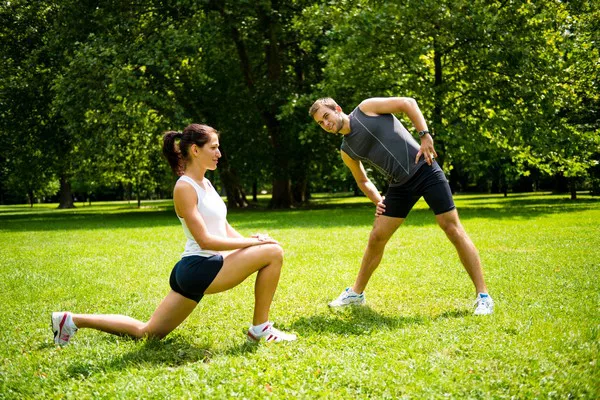In today’s fast-paced world, many people struggle to find time to dedicate to lengthy workout sessions. For those with busy schedules, high-intensity interval training (HIIT) has become an increasingly popular and effective solution. HIIT workouts are designed to deliver maximum fitness benefits in minimal time, making them a fantastic option for individuals who want to get fit without spending hours at the gym.
But what exactly is HIIT, and why has it gained such widespread popularity? In this article, we will dive into the fundamentals of HIIT, explore the science behind its effectiveness, and introduce a variety of HIIT exercises that can help you achieve your fitness goals.
What is High-Intensity Interval Training (HIIT)?
High-intensity interval training, or HIIT, is a type of workout that alternates between short bursts of intense exercise and periods of rest or low-intensity recovery. These intervals can vary in length, but the primary concept behind HIIT is to push your body to its limits for a short period, followed by a brief recovery phase. This cycle repeats several times throughout the workout.
HIIT workouts can be done with various types of exercises, including bodyweight movements, cardio, strength training, or a combination of all three. The key to a successful HIIT workout is intensity—during the high-intensity intervals, you should work as hard as you can, aiming to reach around 80-90% of your maximum effort.
How Does HIIT Work?
The main reason HIIT is so effective lies in the science behind it. When you push your body to work at maximum intensity, you increase your heart rate and force your muscles to work harder than during moderate exercise. This intense effort leads to several benefits:
1. Improved Cardiovascular Health
HIIT increases your heart rate to levels higher than moderate aerobic exercises, improving your cardiovascular fitness. The repeated bursts of intense exercise help strengthen your heart and improve circulation. Over time, this leads to better heart health, improved endurance, and greater oxygen capacity.
2. Fat Loss and Weight Management
One of the most significant benefits of HIIT is its ability to burn fat. Studies have shown that HIIT can be more effective than traditional steady-state cardio in burning fat, particularly in stubborn areas like the belly. The high-intensity intervals elevate your metabolism, allowing your body to burn more calories both during and after the workout. This effect, known as excess post-exercise oxygen consumption (EPOC), means your body continues to burn calories even after you finish exercising.
3. Increased Muscle Strength and Endurance
HIIT workouts often incorporate bodyweight exercises like squats, push-ups, and lunges, which help build and tone muscle. As you push your muscles to their limits during the high-intensity intervals, you stimulate muscle growth and improve muscular endurance. Additionally, some HIIT workouts include weightlifting or resistance training, further enhancing strength gains.
4. Time Efficiency
One of the biggest reasons people are turning to HIIT is the time efficiency it offers. Traditional workouts can take upwards of 60 minutes, whereas HIIT can be completed in as little as 15-30 minutes, making it ideal for those with busy schedules. Despite the shorter duration, the intensity of the workout ensures that you still achieve significant fitness benefits.
5. Improved Metabolic Rate
HIIT helps boost your metabolism, even after the workout is over. The intense effort required during the high-intensity intervals stimulates your body’s metabolic processes, leading to improved fat burning and increased energy expenditure. This metabolic boost is particularly useful for weight loss or maintenance.
6. Enhanced Mental Toughness
HIIT pushes you to work at maximum effort, which challenges not only your physical endurance but also your mental strength. The ability to maintain focus and push through the tough intervals can translate into improved mental toughness, which can benefit you in both workouts and daily life.
What Does a HIIT Workout Look Like?
HIIT workouts can vary significantly depending on your fitness level, goals, and the exercises you prefer. A typical HIIT workout consists of a warm-up, a series of high-intensity intervals followed by recovery periods, and a cool-down. Let’s break down each component:
1. Warm-Up
It’s essential to warm up before any workout, and HIIT is no exception. A proper warm-up prepares your body for the intense activity ahead, increases blood flow to your muscles, and reduces the risk of injury. A 5-10 minute warm-up should include dynamic movements such as leg swings, arm circles, and light cardio (e.g., jogging or jumping jacks) to get your heart rate up.
2. High-Intensity Intervals
The high-intensity intervals are the core of the HIIT workout. These bursts of activity are typically 20-45 seconds long, during which you give your maximum effort. The goal is to push yourself to the limit during each interval, whether that means sprinting, doing jump squats, or performing burpees. The key is to challenge yourself during these periods, so you’re working at around 80-90% of your maximum effort.
3. Recovery Periods
After each high-intensity interval, you enter a recovery phase. The recovery period is crucial as it allows your heart rate to come down slightly and prepares you for the next intense interval. Recovery times typically range from 15 seconds to 1 minute, depending on the specific workout and your fitness level. During the recovery phase, you can either rest completely or engage in low-intensity exercises such as walking or light jogging.
4. Cool-Down
Just as a warm-up is essential, cooling down after a HIIT workout is equally important. Cooling down helps lower your heart rate gradually and reduces muscle stiffness. A cool-down might involve 5-10 minutes of light cardio followed by static stretching to improve flexibility and reduce the risk of soreness.
Common HIIT Exercises
HIIT exercises can be performed using just your body weight, or you can incorporate equipment such as dumbbells, kettlebells, or resistance bands. Here are some of the most effective HIIT exercises that target different muscle groups and boost cardiovascular fitness:
1. Jumping Jacks
Jumping jacks are a classic full-body exercise that gets your heart rate up quickly. They are great for warming up and can also be used as a high-intensity interval exercise. To perform a jumping jack, stand with your feet together and arms by your sides. Jump and spread your legs while raising your arms overhead. Then, return to the starting position and repeat.
2. Burpees
Burpees are one of the most challenging and effective exercises for a full-body HIIT workout. To perform a burpee, start in a standing position, then squat down and place your hands on the floor. Jump your feet back into a plank position, do a push-up, and then jump your feet back towards your hands. Finally, jump up and reach for the sky. Burpees engage the chest, core, legs, and arms, providing a full-body workout.
3. Mountain Climbers
Mountain climbers are excellent for building strength and endurance in the core, shoulders, and legs. Start in a plank position with your hands directly under your shoulders. Bring one knee towards your chest, then quickly switch legs, alternating back and forth as if you’re “climbing” a mountain. The faster you go, the more intense the exercise becomes.
4. Squat Jumps
Squat jumps are a great exercise for building leg strength while also elevating your heart rate. Start by performing a regular squat, then explode upward into a jump. Land softly and go straight into the next squat. This exercise targets the quads, hamstrings, and glutes while also challenging your cardiovascular system.
5. Push-Ups
Push-ups are a classic bodyweight exercise that targets the chest, shoulders, triceps, and core. For HIIT, you can perform regular push-ups or modify them to suit your fitness level. To perform a push-up, start in a plank position with your hands slightly wider than shoulder-width apart. Lower your body towards the floor by bending your elbows, then push back up to the starting position.
6. Lunges
Lunges are a great lower-body exercise that targets the quads, hamstrings, and glutes. To perform a lunge, step forward with one leg, lowering your back knee towards the floor while keeping your front knee aligned with your ankle. Push back to the starting position and repeat on the other leg. To make it more intense, try jumping lunges, where you switch legs in the air.
7. High Knees
High knees are a simple yet effective exercise for getting your heart rate up. Start by standing with your feet hip-width apart. Quickly alternate bringing your knees up towards your chest while maintaining a fast pace. This exercise engages the hip flexors, core, and legs and provides an excellent cardio workout.
8. Plank to Push-Up
This exercise targets the core, shoulders, and chest. Start in a plank position, then lower one arm at a time to the ground into a push-up position. Push back up one arm at a time to return to the plank position. Repeat, alternating arms. This movement challenges your upper body and core stability.
Creating a HIIT Workout Routine
A basic HIIT workout might involve 30-45 seconds of high-intensity exercise followed by 15-30 seconds of rest. For example, you could alternate between exercises like burpees, mountain climbers, and squat jumps, repeating the circuit for 20-30 minutes. You can start with 3-4 rounds of exercises and gradually
increase the intensity or duration as you become more experienced.
A sample HIIT workout could look like this:
Warm-Up: 5 minutes of light jogging or dynamic stretching
HIIT Circuit (repeat 3-4 times):
30 seconds burpees
30 seconds mountain climbers
30 seconds squat jumps
30 seconds high knees
30 seconds rest
Cool-Down: 5 minutes of light jogging or stretching
Conclusion
High-Intensity Interval Training (HIIT) is an incredibly effective and efficient workout method that delivers numerous fitness benefits in a short amount of time. Whether you’re looking to improve cardiovascular health, burn fat, build muscle, or boost your metabolism, HIIT can help you achieve your goals. With a wide variety of exercises to choose from and the flexibility to customize your routine, HIIT is a versatile workout option for people of all fitness levels.
If you’re short on time but still want to challenge yourself and make significant progress, incorporating HIIT into your fitness regimen is an excellent choice. Push your limits, stay consistent, and you’ll see impressive results in no time!



































